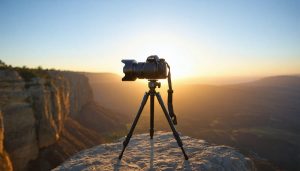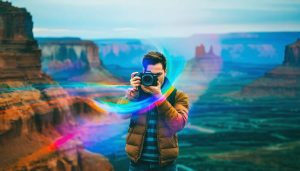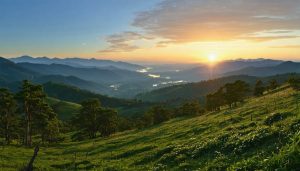
Invest in a versatile camera body with robust autofocus and superior low-light performance; the Nikon D850 or Canon EOS R5 can be great choices. Choose lenses that offer flexibility, like a fast telephoto zoom lens for capturing distant wildlife or a macro lens for intricate plant details. Protect your equipment with weather-resistant bags and sturdy tripods, ensuring stability and safety even in the harshest outdoor conditions. Embrace essential accessories, such as polarizing filters to enhance colors and reduce glare, and lightweight, portable storage solutions for on-the-go image backup.
Cameras: Choosing the Best Type for Nature Photography
DSLRs vs. Mirrorless Cameras
In the realm of nature photography, choosing between a DSLR and a mirrorless camera can feel like a big decision, akin to picking between two trusty hiking boots for an adventure. Each has its own charm and set of skills. DSLRs, the veterans of the field, offer a robust build and an optical viewfinder that gives you a reflection of the real world, perfect for those who value seeing exactly what their lens sees. They are known for great battery life—critical when you’re spending long days capturing nature’s beauty in remote locations. However, they tend to be on the bulkier side, which might weigh you down during extended treks. On the flip side, mirrorless cameras, the nimble newcomers, shine with their compact size and cutting-edge features. They often boast faster, more precise autofocus and, viewing your scene digitally, allows for real-time exposure adjustments that can be invaluable in changing light conditions. However, their shorter battery life could be a downside during long outdoor shoots. For photographers on a budget, exploring affordable cameras might also uncover hidden gems. Ultimately, your choice boils down to personal style and the specific demands of your photographic journey in the wild.

Compact Cameras
Compact cameras offer a fantastic blend of portability and functionality, making them an ideal choice for nature photography enthusiasts at all levels. When you’re hiking through dense forests or navigating rocky terrains, every ounce of weight matters. This is where compact cameras truly shine, providing a lightweight solution without compromising image quality. Many modern compact cameras come equipped with powerful sensors and versatile lenses that can handle a range of shooting conditions, from wide landscapes to intricate close-ups of flora and fauna.
Imagine you’re trekking through a misty morning forest and spot a rare bird perched on a branch – the last thing you want is to fumble with heavy equipment. A compact camera, snug in the palm of your hand or comfortably slung around your neck, allows for quick access to capture the moment perfectly. With features like intuitive controls and automatic settings, you can focus on the creative process rather than technical adjustments.
For instance, photographers exploring rugged terrains might rely on a compact camera’s impressive zoom capability to capture distant subjects without disturbing the natural environment. Additionally, the often silent operation of these cameras is crucial for wildlife photography, ensuring you don’t startle the animals. Whether you’re a hobbyist or a seasoned pro, having a compact camera in your bag can be the key to transforming everyday outdoor experiences into stunning photographic stories.
Essential Lenses for Capturing the Wild
Wide-Angle Lenses
Wide-angle lenses are a game-changer for nature photography, allowing you to capture sweeping landscapes and grand vistas in a single frame. Imagine standing at the rim of a canyon, capturing not just the distant horizon but also the texture of the rocky foreground and the vast sky overhead. These lenses offer a wider field of view, making them perfect for conveying the magnificence of expansive scenes and the scale of nature.
In addition to landscapes, wide-angle lenses are fantastic for capturing intricate details when photographing forests or seaside views where you want to include both the towering trees or crashing waves and the surrounding environment. This lens not only enhances your ability to tell a more complete story of the scene but also offers creative opportunities like playing with perspective. For instance, positioning close to a flower can create a striking foreground, dramatically leading the viewer’s eye through the image.
Whether you’re an enthusiast looking to broaden your scope or a pro seeking to expand your toolkit, wide-angle lenses are essential for pushing the boundaries of your nature photography.
Telephoto Lenses
In the world of nature photography, telephoto lenses are invaluable tools that allow photographers to capture distant subjects with stunning detail. Whether you’re a seasoned professional or a passionate hobbyist, having the right telephoto lens in your gear bag can make a significant difference, especially in wildlife photography, where getting close to your subject isn’t always possible—or advisable. Imagine trying to photograph a majestic lion or a soaring eagle from afar; without a telephoto lens, you’d miss the incredible details that make these shots truly captivating.
Telephoto lenses, which include options like 70-200mm and 100-400mm, bring you closer to the action without physically disturbing wildlife. This is crucial not only for safety but also to ensure you’re observing and capturing animals in their natural habitat undisturbed. In addition to the reach it provides, a good telephoto lens offers a compressed perspective, which can be creatively used to isolate subjects against stunning backgrounds, adding depth and dimension to your images.
Of course, using these lenses requires some skill, and there are common wildlife photography mistakes to avoid, like camera shake due to the lens’s weight or improper focusing techniques. But with practice, and perhaps a sturdy tripod or monopod, you can master the art of using telephoto lenses to elevate your nature photography.

Tripods and Stabilization: Keeping Steady Shots
Tripod Features to Consider
When venturing into the realm of nature photography, choosing the right tripod can significantly enhance your ability to capture breathtaking scenes with stability and versatility. One of the key aspects to consider is the tripod’s weight and material. Lightweight, sturdy options like carbon fiber provide excellent support without being burdensome on long hikes through the wilderness.
Next, examine the tripod’s load capacity. It needs to support your camera’s weight, along with any additional accessories like telephoto lenses or external flashes. For added flexibility, look for tripods with adjustable leg angles and a reversible center column, allowing for low-angle shots—a favorite for capturing intriguing ground-level perspectives of flowers or wildlife.
Also, consider the tripod’s height adjustment features. Having the ability to extend to eye level or compress to lower heights gives you creative freedom in varied terrains. Real-world experience has shown that quick-release mechanisms can save time during rapid setup, which is crucial for seizing those fleeting golden-hour moments. Consider these features as you choose a tripod to complement your nature photography adventures.
Alternative Stabilization Tools
When capturing the essence of nature, stabilization is key to getting sharp and clear images. While tripods are a popular choice, alternative stabilization tools can offer greater flexibility and convenience for photographers on the go. One such option is the monopod, which is lightweight and easy to set up, making it ideal for quick adjustments and tighter spaces where a tripod might be cumbersome. Unlike tripods, monopods allow for more fluid movement, helping you pan smoothly to follow wildlife action.
Another practical tool is a bean bag, which is perfect for stabilizing your camera on uneven surfaces or even the hood of your car. It’s a favorite among wildlife photographers for its adaptability and ease of use in rugged terrains. Additionally, camera harnesses and body mounts offer hands-free support, allowing you to hike comfortably while keeping your camera ready for action. These tools ensure that even when you’re navigating challenging landscapes, you don’t compromise on the quality of your shots.
Protective Gear and Accessories
Weather Protection for Equipment
When venturing into nature photography, safeguarding your equipment from weather elements is paramount. Rain, snow, dust, and humidity can wreak havoc on delicate gear, but several solutions can help. First, consider investing in weather-sealed cameras and lenses; many professional-grade options are designed to resist moisture and dust. For those without such features, camera rain covers or sleeves are affordable and effective alternatives. These covers act like raincoats, allowing you to shoot in wet conditions without risking damage. Don’t forget about silica gel packets; these handy little dehumidifiers can absorb moisture inside your camera bag. Utilize lens hoods to shield against rain and stray light, offering protection and enhancing image quality. By adopting these simple practices, you can confidently capture nature’s beauty, regardless of the weather.
Personal Protective Gear
When venturing into the wild for nature photography, personal safety is as important as capturing the perfect shot. Equipping yourself with the right protective gear ensures a safe and comfortable experience, allowing you to focus on your artistry without distractions. Start with moisture-wicking layers to keep you dry and warm, topped with a waterproof jacket for unexpected weather shifts. A sturdy pair of waterproof hiking boots will protect your feet from rough terrain and wet conditions. Gloves and a hat are essential; they keep you warm in cold climates, ensuring your hands remain steady for those critical moments. Finally, a high-quality backpack not only secures your gear but also supports your back, making those long hikes less strenuous. Prioritizing personal protective gear means more time to connect with nature and frame those unforgettable moments.
Bonus Tools for Enhancing Your Nature Photography
Using Filters for Better Shots
When capturing the beauty of nature, using filters can be a game-changer in your photography. First up, the polarizing filter, which reduces reflections on water and enhances the saturation of the sky, making blues and greens pop—a critical addition to your landscape gear essentials. Then there’s the neutral density filter, perfect for long exposures. It allows you to blur elements like flowing water or clouds without overexposing your shot. Graduated ND filters come in handy when balancing bright skies with darker landscapes. Imagine shooting a vibrant sunset where the foreground is just as beautifully detailed as the horizon. Filters also serve to protect your lens from dust and scratches, ensuring your gear lasts through countless adventures. Each filter offers unique capabilities, ready to transform your images from ordinary to extraordinary.
Incorporating Drones
Have you ever wondered what it would be like to capture nature’s beauty from a bird’s-eye view? Drones are revolutionizing the field of nature photography, offering stunning perspectives that were once out of reach. With their ability to soar high above landscapes, drones allow photographers to capture intricate patterns of forests, winding rivers, and expansive mountain ranges, elevating the artistry of your shots. Whether you’re a seasoned pro or a hobbyist, investing in one of the top camera drones can open up a new world of possibilities. Imagine capturing the golden hues of a sunset reflected on a tranquil lake or the sheer cliffs of a hidden canyon. While it’s essential to be mindful of regulations and respect wildlife, the addition of a drone to your gear can enhance your ability to tell compelling stories from unexpected angles.

Conclusion
In capturing the breathtaking beauty of nature, selecting the right photography gear can make a significant difference, transforming your vision into reality. Throughout this article, we’ve explored the various elements integral to this pursuit: cameras that promise clarity, lenses that bring distinct perspectives into focus, and support equipment like tripods that offer the stability every image deserves. Whether you’re setting out on a solo hike or embarking on a photography expedition, understanding how each piece of gear contributes to your creative toolkit is crucial. Professional photographers and hobbyists alike can benefit from thoughtfully chosen equipment that aligns with their goals, allowing for the seamless execution of every shot. Ultimately, the art of nature photography hinges not just on the technology at our disposal, but how we harness it to tell nature’s stories through our unique lens. Equip yourself wisely, and you’ll find endless opportunities to capture the wonders of the natural world.
















